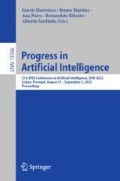Abstract
Natural Language Processing techniques usually fail to classify low quality lawsuit document images produced by a flatbed scanner or fax machine or even captured by mobile devices, such as smartphones or tablets. As the courts of justice have many lawsuits, the manual detection of classification errors is unfeasible, favouring fraud, such as using the same payment receipt for more than one fee. An alternative to classifying low-quality document images is visual-based methods, which extract features from the images. This article proposes classification models for lawsuit document image processing using transfer learning to train Convolutional Neural Networks most quickly and obtain good results even in smaller databases. We validated our proposal using a TJSP dataset composed of 2,136 unrecognized document images by Natural Language Processing techniques and reached an accuracy above 80% in the proposed models.
Access this chapter
Tax calculation will be finalised at checkout
Purchases are for personal use only
References
Abuelwafa, S., Pedersoli, M., Cheriet, M.: Unsupervised exemplar-based learning for improved document image classification. IEEE Access 7, 133738–133748 (2019)
Ashir, A.M.: Multilevel thresholding for image segmentation using mean gradient. J. Electr. Comput. Eng. 2022 (2022)
Braz, F.A., et al.: Document classification using a bi-lstm to unclog brazil’s supreme court. arXiv e-prints pp. arXiv-1811 (2018)
Chen, N., Blostein, D.: A survey of document image classification: problem statement, classifier architecture and performance evaluation. Int. J. Doc. Anal. Recogn. 10(1), 1–16 (2007)
Clark, A.: Pillow (pil fork) documentation. Readthedocs (2015). https://Buildmedia.Readthedocs.Org/Media/Pdf/Pillow/Latest/Pillow.Pdf
Coelho, L.P.: Mahotas: Open source software for scriptable computer vision. arXiv preprint arXiv:1211.4907 (2012)
Csurka, G., Larlus, D., Gordo, A., Almazan, J.: What is the right way to represent document images? arXiv preprint arXiv:1603.01076 (2016)
Das, A., Roy, S., Bhattacharya, U., Parui, S.K.: Document image classification with intra-domain transfer learning and stacked generalization of deep convolutional neural networks. In: International Conference on Pattern Recognition, pp. 3180–3185 (2018)
Deng, G., Cahill, L.: An adaptive gaussian filter for noise reduction and edge detection. In: IEEE Conference Record Nuclear Science Symposium and Medical Imaging Conference, vol. 3, pp. 1615–1619 (1993)
DeTone, D., Malisiewicz, T., Rabinovich, A.: Superpoint: self-supervised interest point detection and description. In: IEEE Conference on Computer Vision and Pattern Recognition Workshops, pp. 224–236 (2018)
Dusmanu, M., et al.: D2-net: a trainable CNN for joint description and detection of local features. In: IEEE Conference on Computer Vision and Pattern Recognition, pp. 8092–8101 (2019)
Haralick, R.M., Shanmugam, K., Dinstein, I.H.: Textural features for image classification. IEEE Trans. Syst. Man Cybern. 1(6), 610–621 (1973)
Harley, A.W., Ufkes, A., Derpanis, K.G.: Evaluation of deep convolutional nets for document image classification and retrieval. In: International Conference on Document Analysis and Recognition (2015)
Jain, S., Dhar, J.: Image based search engine using deep learning. In: 2017 Tenth International Conference on Contemporary Computing, pp. 1–7. IEEE (2017)
Ketkar, N.: Introduction to Keras. In: Deep Learning with Python, pp. 95–109. Apress, Berkeley, CA (2017). https://doi.org/10.1007/978-1-4842-2766-4_7
Kumar, J., Doermann, D.: Unsupervised classification of structurally similar document images. In: International Conference on Document Analysis and Recognition, pp. 1225–1229 (2013)
Liu, L., Wang, Z., Qiu, T., Chen, Q., Lu, Y., Suen, C.Y.: Document image classification: progress over two decades. Neurocomputing 453, 223–240 (2021)
Liu, Y., Xu, X., Li, F.: Image feature matching based on deep learning. In: IEEE 4th International Conference on Computer and Communication, pp. 1752–1756 (2018)
Nguyen, T.-S., Nguyen, L.-M., Tojo, S., Satoh, K., Shimazu, A.: Recurrent neural network-based models for recognizing requisite and effectuation parts in legal texts. Artif. Intell. Law 26(2), 169–199 (2018). https://doi.org/10.1007/s10506-018-9225-1
Otsu, N.: A threshold selection method from gray-level histograms. IEEE Trans. Syst. Man Cybern. 9(1), 62–66 (1979)
Polo, F.M., Ciochetti, I., Bertolo, E.: Predicting legal proceedings status: approaches based on sequential text data. In: Proceedings of the Eighteenth International Conference on Artificial Intelligence and Law, pp. 264–265 (2021)
Polo, F.M., et al.: Legalnlp-natural language processing methods for the Brazilian legal language. arXiv preprint arXiv:2110.15709 (2021)
da Silva, N.C., et al.: Document type classification for Brazil’s supreme court using a convolutional neural network. In: International Conference on Forensic Computer Science and Cyber Law (ICoFCS), Sao Paulo, Brazil, pp. 29–30 (2018)
Simonyan, K., Zisserman, A.: Very deep convolutional networks for large-scale image recognition. In: International Conference on Learning Representations, pp. 1–14 (2015)
Sulea, O.M., Zampieri, M., Malmasi, S., Vela, M., Dinu, L.P., Van Genabith, J.: Exploring the use of text classification in the legal domain, pp. 1–5 (2017). arXiv preprint arXiv:1710.09306
de Tecnologia da Informação do Tribunal de Justiça de São Paulo, S.: Tribunal de justiça - estado de são paulo: a justiça próxima do cidadão (2022). https://www.tjsp.jus.br/QuemSomos
Xu, Y., Zhang, M., Wu, S., Hu, J.: Lawsuit category prediction based on machine learning. In: IEEE International Conference on Intelligence and Security Informatics, pp. 176–178. IEEE (2019)
Zhang, Z., Lee, W.S.: Deep graphical feature learning for the feature matching problem. In: IEEE/CVF International Conference on Computer Vision, pp. 5087–5096 (2019)
Author information
Authors and Affiliations
Corresponding author
Editor information
Editors and Affiliations
Rights and permissions
Copyright information
© 2022 The Author(s), under exclusive license to Springer Nature Switzerland AG
About this paper
Cite this paper
Freire, D.L. et al. (2022). Lawsuits Document Images Processing Classification. In: Marreiros, G., Martins, B., Paiva, A., Ribeiro, B., Sardinha, A. (eds) Progress in Artificial Intelligence. EPIA 2022. Lecture Notes in Computer Science(), vol 13566. Springer, Cham. https://doi.org/10.1007/978-3-031-16474-3_4
Download citation
DOI: https://doi.org/10.1007/978-3-031-16474-3_4
Published:
Publisher Name: Springer, Cham
Print ISBN: 978-3-031-16473-6
Online ISBN: 978-3-031-16474-3
eBook Packages: Computer ScienceComputer Science (R0)

